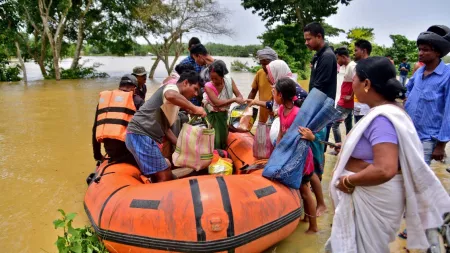Incessant rainfall over the past few weeks in the North-East Indian states has led to rising water levels in the North-East part of Bangladesh, causing flash floods in the region. Several places in the five districts of the region are inundated. According to the latest update by Flood Forecasting and Warning Centre (FFWC), water is flowing above danger levels (up to 1m) in several gauge stations of the two major rivers in the region. It is expected that more districts will be affected as the waters recede from the current location to the following low-lying areas.
Ram Das, Deputy Country Director, Programs for CARE Bangladesh, expressed his concern saying, "Unprecedented weather events such as this flash flood are becoming more frequent in the recent years. It indicates the changing pattern in the climate, which is a global concern, more so for countries like Bangladesh, which has been repeatedly affected by extreme weather events for a long time, making it seventh in the world’s most climate change affected countries."
The Needs Assessment Working Group (NAWG), of which CARE is a co-chair, reported that an estimated 2 million people are affected by the current flash flood. Water, sanitation, and hygiene (WASH), health, education, gender-based violence (GBV) protection, shelter, food & livelihood (agriculture, livestock, market, fisheries) are highly affected due to the floods. More than 400 shelter centers have been opened by the Government of Bangladesh (GoB), and an estimated 5,000+ people are living in these shelters. GoB has also initiated response by providing dry food, allocation of rice, and cash grants to the respective districts; however, it is inadequate.
Under CARE's portfolio, Dwarabazar sub-district in Sunamganj from USAID’s SHOUHARDO III project has been impacted; needs and damages assessment of this region has already been initiated. CARE's three emergency partners are present in the affected districts, ready to dispatch if the situation escalates.
"As a part of CARE’s mandate to respond to climate change-induced crises, for this flash flood, CARE aims to reach 5,000 people in Sylhet city corporation and other affected areas primarily through our local partners. The initial response will cover WASH, emergency shelter, health, and protection services for gender-based violence.”, added Ram Das.
Additional information: Despite being a nano-emitter of CO2, Bangladesh ranks seventh in the world in countries most affected by climate-related extreme weather events. Bangladesh is a world leader in adapting to climate impacts, and CARE is working hard to build the resilience of individuals, communities and systems. Still, the pace of climate change is happening faster than we can adapt, and the losses and damages are becoming more extreme, making people more vulnerable and destitute.
About CARE: Founded in 1945 with the creation of the CARE Package®, CARE is a leading humanitarian organization fighting global poverty. CARE has more than seven decades of experience delivering emergency aid during times of crisis. Our emergency responses focus on the needs of the most vulnerable populations, particularly girls and women. In 2020, CARE worked in over 100 countries, reaching more than 90 million people through 1,300 projects. To learn more, visit www.care.org and www.care-international.org.
For media inquiries, please contact Nusrat Daud Pritha, Acting Head – Communications and PR Unit for CARE Bangladesh: E: [email protected]; M: +8801711731055
